
The classical guitar is a member of the guitar family used in classical music. An acoustic wooden string instrument with strings made of gut or nylon, it is a precursor of the modern acoustic and electric guitars, both of which use metal strings. Classical guitars are derived from the Spanish vihuela and gittern in the fifteenth and sixteenth century, which later evolved into the seventeenth and eighteenth-century Baroque guitar and later the modern classical guitar in the mid-nineteenth century.

An electric guitar is a guitar that requires external amplification in order to be heard at typical performance volumes, unlike a standard acoustic guitar. It uses one or more pickups to convert the vibration of its strings into electrical signals, which ultimately are reproduced as sound by loudspeakers. The sound can be shaped or electronically altered to achieve different timbres or tonal qualities, making it quite different from an acoustic guitar. Often, this is done through the use of effects such as reverb, distortion and "overdrive"; the latter is considered to be a key element of electric blues guitar music and rock guitar playing.

The guitar is a fretted musical instrument that typically has six strings. It is held flat against the player's body and played by strumming or plucking the strings with the dominant hand, while simultaneously pressing the strings against frets with the fingers of the opposite hand. A plectrum or individual finger picks may be used to strike the strings. The sound of the guitar is projected either acoustically, by means of a resonant chamber on the instrument, or amplified by an electronic pickup and an amplifier.

A fret is a space between two fretbars on the neck of a stringed instrument. Frets usually extend across the full width of the neck. On most modern western fretted instruments, frets are the spaces between the metal strips (fretbars) that are inserted into the fingerboard. On some historical instruments and non-European instruments, frets are made of pieces of string tied around the neck.
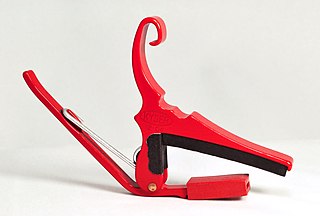
A capo is a device a musician uses on the neck of a stringed instrument to transpose and shorten the playable length of the strings—hence raising the pitch. It is a common tool for players of guitars, mandolins, mandolas, banjos, ukuleles and bouzoukis. The word derives from the Italian capotasto, which means the nut of a stringed instrument. The earliest known use of capotasto is by Giovanni Battista Doni who, in his Annotazioni of 1640, uses it to describe the nut of a viola da gamba. The first patented capo was designed by James Ashborn of Wolcottville, Connecticut year 1850.

The bağlama is a stringed musical instrument.
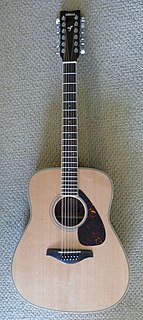
The 12-string guitar is a steel-string guitar with 12 strings in six courses, which produces a thicker, more ringing tone than a standard six-string guitar. Typically, the strings of the lower four courses are tuned in octaves, with those of the upper two courses tuned in unison. The gap between the strings within each dual-string course is narrow, and the strings of each course are fretted and plucked as a single unit. The neck is wider, to accommodate the extra strings, and is similar to the width of a classical guitar neck. The sound, particularly on acoustic instruments, is fuller and more harmonically resonant than six-string instruments.
The fingerboard is an important component of most stringed instruments. It is a thin, long strip of material, usually wood, that is laminated to the front of the neck of an instrument. The strings run over the fingerboard, between the nut and bridge. To play the instrument, a musician presses strings down to the fingerboard to change the vibrating length, changing the pitch. This is called stopping the strings. Depending on the instrument and the style of music, the musician may pluck, strum or bow one or more strings with the hand that is not fretting the notes. On some instruments, notes can be sounded by the fretting hand alone, such as with hammer ons, an electric guitar technique.

The highly diverse and distinctive music of Madagascar has been shaped by the musical traditions of Southeast Asia, Africa, Arabia, England, France and the United States over time as indigenous people, immigrants, and colonists have made the island their home. Traditional instruments reflect these widespread origins: the mandoliny and kabosy owe their existence to the introduction of the guitar by early Arab or European seafarers, the ubiquitous djembe originated in mainland Africa and the valiha—the bamboo tube zither considered the national instrument of Madagascar—directly evolved from an earlier form of zither carried with the first Austronesian settlers on their outrigger canoes.

The Appalachian dulcimer is a fretted string instrument of the zither family, typically with three or four strings, originally played in the Appalachian region of the United States. The body extends the length of the fingerboard, and its fretting is generally diatonic.

The kobza, also called bandurka is a Ukrainian folk music instrument of the lute family, a relative of the Central European mandora. The term kobza however, has also been applied to a number of other Eastern European instruments distinct from the Ukrainian kobza.
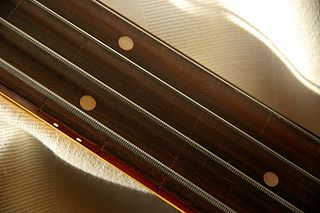
A string is the vibrating element that produces sound in string instruments such as the guitar, harp, piano, and members of the violin family. Strings are lengths of a flexible material that a musical instrument holds under tension so that they can vibrate freely, but controllably. Strings may be "plain", consisting only of a single material, like steel, nylon, or gut, or wound, having a "core" of one material and an overwinding of another. This is to make the string vibrate at the desired pitch, while maintaining a low profile and sufficient flexibility for playability.

Purfling is a narrow decorative edge inlaid into the top plate and often the back plate of a stringed instrument. Inexpensive instruments may have no purfling and instead simulate the appearance with paint.
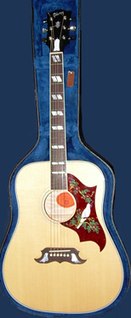
A pickguard is a piece of plastic or other material that is placed on the body of a guitar, mandolin or similar plucked string instrument. The main purpose of the pickguard is to protect the guitar's finish from being scratched by the guitar pick.
A nut, on a stringed musical instrument, is a small piece of hard material that supports the strings at the end closest to the headstock or scroll. The nut marks one end of the vibrating length of each open string, sets the spacing of the strings across the neck, and usually holds the strings at the proper height from the fingerboard. Along with the bridge, the nut defines the scale lengths of the open strings.
In music, intonation is the pitch accuracy of a musician or musical instrument. Intonation may be flat, sharp, or both, successively or simultaneously.
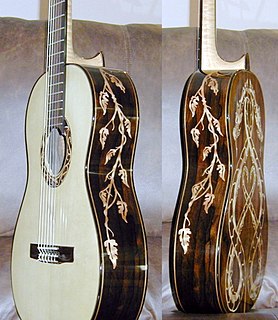
Inlay on guitars or similar fretted instruments are decorative materials set into the wooden surface of the instrument using standard inlay techniques. Although inlay can be done on any part of a guitar, it is most commonly found on the fretboard, headstock—typically the manufacturer's logo—and around the sound hole of acoustic guitars. Only the positional markers on the fretboard or side of neck and the rosette around the sound hole serve any function other than decoration. Nacre, plastic and wood are the materials most often used as inlay.
The scale length of a string instrument is the maximum vibrating length of the strings that produce sound, and determines the range of tones that string can produce at a given tension. It is also called string length. On instruments in which strings are not "stopped" or divided in length it is the actual length of string between the nut and the bridge.
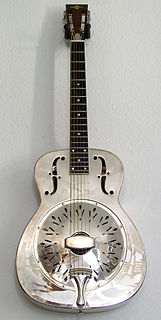
A resonator guitar or resophonic guitar is an acoustic guitar that produces sound by conducting string vibrations through the bridge to one or more spun metal cones (resonators), instead of to the guitar's sounding board (top). Resonator guitars were originally designed to be louder than regular acoustic guitars, which were overwhelmed by horns and percussion instruments in dance orchestras. They became prized for their distinctive tone, however, and found life with bluegrass music and the blues well after electric amplification solved the problem of inadequate volume.

A flamenco guitar is a guitar similar to a classical guitar but with thinner tops and less internal bracing. It usually has nylon strings, like the classical guitar, but it generally possesses a livelier, more gritty sound compared to the classical guitar. It is used in toque, the guitar-playing part of the art of flamenco.


















